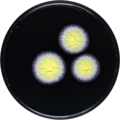| Aspergillus tonophilus | |
|---|---|
| Scientific classification | |
| Kingdom: | Fungi |
| Division: | Ascomycota |
| Class: | Eurotiomycetes |
| Order: | Eurotiales |
| Family: | Aspergillaceae |
| Genus: | Aspergillus |
| Species: | A. tonophilus |
| Binomial name | |
| Aspergillus tonophilus Ohtsuki (1962) [1] | |
Aspergillus tonophilus is a species of fungus in the genus Aspergillus . It is from the Aspergillus section. [2] The species was first described in 1962. [1] It has been reported to produce auroglaucin, bisanthrons, dihydroauroglaucin, echinulins, flavoglaucin, an apolar indoloterpene, isoechinulins, neoechinulins, and tetrahydroauroglaucin. [2]

